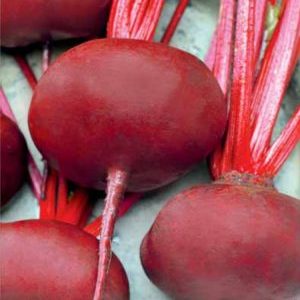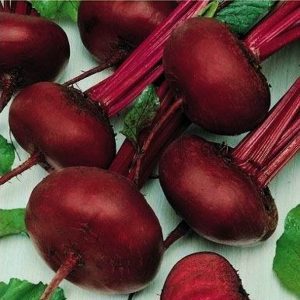Consistently yielding and incredibly tasty Egyptian flat beets for the best borscht, preparations and salads
Flat Egyptian beet is a well-known and well-known variety. The culture is in great demand among amateur summer residents and professional farmers due to its many positive qualities. An unpretentious cultivar in cultivation can be recommended for beginners - failures when planting it are extremely rare.
The content of the article
Description of the variety
Egyptian flat beet tolerates drought well, unfavorable weather conditions, is resistant to flowering. Unpretentious care, stability and excellent taste make this variety one of the most popular among gardeners.
Origin and development
Refers to varieties of medium ripening. The variety was bred at the N.I. V.V. Dokuchaev in the 40s of the last century. During this time, it has spread widely throughout Russia.
Egyptian flat is zoned in the Central, Central Black Earth, Ural, Siberian and Far Eastern regions. The variety belongs to the canteen category and is considered to be stable in terms of yield.
Distinctive features

Beets have a ripening period of 3 to 4 months and can grow in most climatic zones of the country.
The root crop has a shape that is characteristic only of this variety, flattened on top, the height of the vegetable is less than the width. The leaf rosette is erect, the foliage is bright green.
Fruit characteristics, yield
The root crop has a flat-rounded shape, a height of 6-8 cm, a width of 7-12 cm. The vegetable is submerged in the soil at half the height, it is painted in an intense purple color. The mass of the root crop ranges from 300 to 500 g. The skin is thin, easily removable.
The pulp has a dark red color, the color is uniform, without white streaks and rings. The taste of the variety is assessed as excellent. Due to the dark color of the pulp, the variety contains a large amount of betaine, which regulates fat metabolism.
The yield of the variety is 3-8 kg per sq. m. It has good keeping quality and can be stored until March.
How to grow
Egyptian flat beets have their own cultivation characteristics.
Planting with seeds
An important stage is the correct preparation of the garden. Good predecessors are legumes, onions, cucumbers, grains. Beets grow worse if tomatoes or cabbage grew in the garden before it. Does not tolerate shading, good lighting of the site is required.
The culture does not tolerate alkaline and acidic soils, the soil must be slightly acidic or neutral.
When digging the beds in the spring, the following mineral fertilizers are applied: 1-2 tbsp. l. superphosphate, 1 tbsp. l. potassium sulfate, 1 tbsp. l. ammonium nitrate per 1 m². With increased acidity of the soil, add dolomite flour or lime. If the soil is not nutritious enough, organic matter is introduced into the soil.
Sowing can be started when the soil temperature warms up to 15 ° C, otherwise the beets will turn into color. Before sowing, the seeds are soaked for a day. When planting, the distance between the rows is 20-25 cm, in a row - 4-5 cm.The seeds are buried in the soil by 2-3 cm.
Reference! The specific property of beets - 2-3 seedlings emerge from one seed. Therefore, in the phase of 1-2 true leaves, the seedlings must be thinned out, leaving the most powerful ones.
Planting seedlings
To get an early harvest, beets are grown as seedlings. For sowing seedlings, seeds are disinfected in a solution of potassium permanganate and placed in a humid environment for 2-3 days until sprouts appear.The tray and soil are spilled for safety with phytosporin.
Seeds are sown for seedlings at the end of April, and bushes are planted in the ground in mid-May.
Care
The cultivation technology is simple. But in order for the beets to grow large enough, tasty and well stored, you just need to observe the basic care rules.
When young plants have 2 true leaves, re-thinning is carried out. The distance between the plants is left depending on what size of the root crop you want to get. If you need larger vegetables, it is recommended to make the distance between the plants 8-10 cm. But keep in mind that medium and small roots have a brighter color and much tastier.
After thinning, the beets are fed for the first time with a solution of slurry or chicken droppings. When the tops are closed, top dressing is carried out with potash fertilizer (for example, ash) for better formation of root crops. Beetroot responds well to foliar dressing (for tops) with complex mineral fertilizers with microelements in a solution of low concentration.
Beet planting must be weeded and loosened regularly, from emergence to closing. leaves... Loosen to a depth of 5 cm to prevent crusting on the soil. It is especially important to carry out loosening after watering or precipitation.
Row spacings can be covered with mown grass. This will facilitate maintenance: there will be no need to carry out weeding, loosening, the soil will dry out less.
Watered beets infrequently, only if the soil dries out. When watering, the soil is moistened to a depth of at least 20 cm with a volume of at least 2-3 buckets per 1 m² of the garden.
Features of cultivation and possible difficulties
Beetroot growers may encounter certain difficulties when growing beets:
- It is better to sow the beets later than early. When seeds are planted in cold soil, the mechanism for the formation of root crops is disrupted, the plants go to the tops, get sick with flowering.
- When planting in soil with a lot of peat (it is usually very acidic), you can be left without a crop. Beets grow weak and frail, root crops are small, tasteless, poorly stored.
The nuances of breeding include the feature to lie down after watering at a young age. This should not be allowed: gently lift the young shoots.
We must not forget that beets, like any root crop, are prone to the accumulation of nitrates. Therefore, it is extremely important when applying fertilizers to the soil in spring and when feeding, observe the norms specified in the instructions.
Attention! The culture responds very well to watering with saline: 1 tbsp. l. 10 liters of water. After such dressings, root crops acquire a richer taste and are better stored in winter.
Diseases and pests
Major diseases:
- Fomoz arises from a lack of boron. It manifests itself as brown spots on the leaves and spoilage of root crops. Prevention - timely feeding with microelements.
- Cercosporosis causes damage to foliage, which soon dies off. May cause crop loss. When a disease occurs, the plants are fed with potassium chloride. As a prophylactic agent, the drug "Agat-25" is used for dressing seeds before planting.

- Peronosporosis (downy mildew) occurs in cold, rainy weather. A bluish velvety bloom appears on the inner surface of the leaves. When a disease occurs, the seedlings are sprayed with a fungicide.
- Corneed affects mainly young plants, is manifested by blackening of the stems. This disease develops on heavy soils due to lack of oxygen or when a dense crust appears in the garden. In order to prevent planting, they regularly loosen, mulch the aisles.
- Fusarium rot appears in early summer on plants damaged or weakened by drought. The leaf plates wither, the quality of root crops decreases. Such beets do not last long. Remove affected plants immediately.
The main pests are miner flies, aphids, fleas and scoops.
When aphids appear, folk remedies are used, for example, a solution of onion peels. If the lesion is severe, spray with Iskra Bio insecticide.
Miner flies are fought with karbofos. Flea beetles are removed by sprinkling ash or tobacco dust on the plants. The scoop is destroyed by means of bacterial action.
Harvesting and application of the crop
Flat Egyptian beet - medium-ripening variety. You can eat young roots from the end of July or early August... But the main harvest is in September. The culture has good keeping quality, so it is dug up for winter storage... The signal to start cleaning is yellowing and drying of the tops.
Choose a sunny day for cleaning. Using a pitchfork, carefully dig up the roots, being careful not to damage them. The tops are cut with a sharp knife, and the beets are cleaned from the ground with your hands. Then the crop is laid out on the site so that the vegetables dry out. Beets are carefully sorted out, rejecting damaged or rotten ones. Well-dried root crops are stored indoors at an optimum temperature of 0-2 ° C and a humidity of no more than 90%.
Damaged and injured vegetables are processed.
There are many recipes for preparations for the winter: borsch dressing, pickled beets, various salads. Due to its rich pulp color, Egyptian flat is ideal as an additional ingredient when pickling cabbage and other vegetables.
But best to eat beets without preservation, because it contains such useful minerals as magnesium, iodine and manganese. Beet helps to remove radionuclides and heavy metals from the body. Beetroot juice is used in the treatment of many diseases.
Experienced gardeners say that borscht and “herring under a fur coat” made from Egyptian flat beets have excellent taste.
Advantages and disadvantages of the variety
The variety is appreciated by gardeners for the following qualities:
- stability and productivity;
- unpretentiousness in growing;
- tolerates drought well;
- dark flesh without white streaks, thin skin and high sugar content.
Many gardeners love the flat shape of the vegetable. It is more convenient to cut it, flat roots are stored more tightly.
The disadvantages of the variety include:
- exactingness to well-lit and heated areas;
- because of the sweet taste, vegetables are often damaged by rodents;
- only large root crops are well stored, medium and small ones dry out quickly.
Farmers reviews
According to farmers, the Egyptian flat beet variety is quite suitable for planting in large areas.
Tatiana, Bezhetsk: «I like Egyptian flat for its uniform dark color, good taste. It looks beautiful on the beds, rising above the ground by half of its height, while it does not require additional measures when growing. "
Vera, Nizhny Novgorod: "This variety has almost no flaws. It grows well, grows without causing trouble, at the end of August it is already ready for harvesting. Keeps perfectly until spring. "
Alina, Goryachy Klyuch: “I would like to note that this beet variety is not picky, it tolerates drought, heat, and does not suffer from bloom. To improve the quality of root crops, we feed them twice with an ash solution and spray them with salted water. "
Conclusion
Consistently high productivity, unpretentiousness and drought resistance make this vegetable very attractive for growing. The convenient shape of the roots, color and high taste provide the market demand. The variety is well stored until spring, which is convenient for the gradual sale of goods.